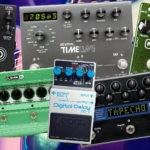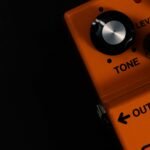When discussing guitar pedals or amplifiers, the term “headroom” frequently comes up. Headroom is a crucial concept that can significantly impact your sound and playing experience. Let’s explore what headroom means, why it’s important, and how it affects your gear.
What is Headroom?
In the context of audio equipment, headroom refers to the difference between the normal operating level of the signal and the maximum level the equipment can handle without distorting. Essentially, it’s the amount of “space” an audio signal has before it reaches the point of clipping, which is when the signal exceeds the limits of the device and distorts.
- High Headroom: Equipment with high headroom can handle a wide dynamic range, meaning it can accept stronger input signals without distorting.
- Low Headroom: Equipment with low headroom will distort more easily when the input signal strength increases.
Headroom in Guitar Pedals
For guitar pedals, headroom determines how well the pedal can handle the signal from your guitar, especially if you have high-output pickups or if you’re boosting the signal with another pedal.
- Clean Boost Pedals: High headroom is critical for clean boost pedals because you want to increase the signal’s volume without adding unwanted distortion.
- Overdrive/Distortion Pedals: While these pedals are designed to distort, having some degree of headroom can allow for a more dynamic range, making the distortion sound more musical and less harsh.
- Compressor Pedals: Headroom in compressors affects how much you can compress the signal before it starts to sound squashed or unnatural.
Headroom in Amplifiers
Amplifier headroom refers to the amp’s ability to handle high signal levels before distorting. This characteristic is essential for both clean and overdriven tones.
- Clean Tones: A high-headroom amp can produce louder clean sounds without breaking up. This is particularly desirable in genres like jazz or country, where clean tones are preferred.
- Overdriven Tones: While some distortion is sought after, having ample headroom ensures that the distortion is controlled and pleasant rather than harsh and uncontrollable. For example, tube amps with high headroom provide smooth, musical overdrive at high volumes.
Why Headroom Matters
Understanding headroom is vital for several reasons:
- Tone Control: Having enough headroom allows for greater control over your tone, especially if you’re using multiple effects pedals or have a high-output guitar.
- Dynamic Range: More headroom means your playing dynamics are preserved, allowing soft and loud notes to be clearly articulated without unwanted distortion.
- Versatility: Gear with high headroom can handle various musical styles and signal levels, making it more versatile in different playing situations.
Managing Headroom
To manage and optimize headroom in your rig:
- Adjust Gain Stages: Keep an eye on the gain settings at each stage of your signal chain. Avoid excessive boosting that might push the signal into unwanted distortion.
- Use Quality Cables: Ensure that you’re using good quality cables to avoid signal loss and maintain headroom.
- Match Gear Properly: Pair pedals and amps with compatible headroom characteristics to get the best sound.
Conclusion
Headroom is a fundamental concept that affects the performance and sound of your pedals and amplifiers. By understanding and managing headroom, you can ensure that your gear responds well to your playing style and maintains the desired tonal quality. Whether you’re aiming for pristine cleans or smooth overdrive, the right amount of headroom is key to achieving your perfect sound.









